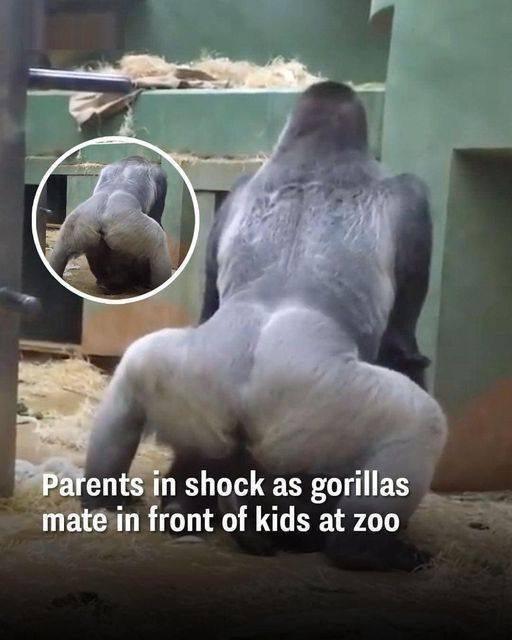A recent visit to the zoo turned into an unforgettable experience for a group of visitors who witnessed an unplanned lesson on the “birds and the bees,” delivered by none other than the resident gorillas. What was supposed to be a regular day of observing animals in their enclosures quickly transformed into an eye-opening, and somewhat awkward, spectacle as the gorillas displayed their natural behavior right in front of an unsuspecting crowd.
It all began as the group gathered around the gorilla enclosure, where a powerful silverback gorilla and a smaller female companion captured everyone’s attention. Initially, the interaction appeared to be typical gorilla behavior—innocent and intriguing to watch. However, as the silverback began to court the female, the situation quickly escalated into something much more intimate. The onlookers, many of whom were families with young children, found themselves in the midst of a live demonstration of gorilla mating rituals.
The reaction from the crowd was a mix of shock, amusement, and discomfort. Children, in particular, were both fascinated and confused by what they were witnessing. One child, struggling to process the situation, exclaimed in distress, “Okay, no, no, no! I’ve seen too much,” while another innocently questioned, “Are they having sex?” The adults, many of whom were likely unprepared for such an event, tried to navigate the moment with humor and discretion, but the situation had already taken on a life of its own.
As the mating progressed, a young gorilla, curious about the commotion, approached the couple. This young onlooker’s actions added an unexpected and somewhat humorous twist to the event. The young gorilla watched intently, then reached out and placed its hand on the silverback’s back, as if to check on the proceedings. This gesture, observed by a woman in the crowd, led her to comment, “The child is coming to look. He’s checking what he is doing!” The combination of the gorillas’ actions and the reactions from the crowd made for a moment that was both entertaining and enlightening.
The scene reached its peak when, after completing the act, the silverback nonchalantly walked away, leaving the female gorilla lying on the ground in a state of exhaustion. As the female slowly got up and began to eat, the same woman who had been narrating the event humorously remarked, “She can’t walk anymore.” This light-hearted commentary added to the overall amusement of the situation, even as some visitors grappled with explaining what had just happened to their children.
The incident quickly went viral, with videos and stories spreading across social media. The reactions online mirrored those at the zoo, with many people finding humor in the situation. One commenter joked, “That little one went to check…Patted on his back, yep! [you’re] in!” while another highlighted the candid conversation captured on video: “Mom: this is how you were made. Child: yeah, I know.” These comments, though humorous, also underscore the naturalness of the event and the unexpected ways in which such moments can spark conversations about life and biology.
Despite the initial shock, some online commentators took the opportunity to reflect on the similarities between gorilla and human behavior. One person observed, “Big Fella just got up and walked away when he was done. You could tell she wanted to cuddle,” drawing a parallel to human interactions. Another found humor in the silverback’s casual attitude, saying, “The way he lifts his foot and twitches his toes hahaha.” These observations highlight the often-unseen aspects of animal behavior that, when viewed through a human lens, can seem both familiar and amusing.
Beyond the humor, the incident also served as a reminder of the realities of the natural world. For many visitors, especially children, the event was an unplanned but valuable learning experience. It brought to the forefront the fact that animals, even in captivity, continue to act according to their natural instincts. This can sometimes lead to surprising and educational moments that challenge our understanding of the animal kingdom.
The scene at the zoo not only provided an unexpected lesson in biology but also sparked broader discussions about the role of zoos in educating the public. Zoos are often seen as places for learning, where people can observe animals and gain a deeper understanding of the natural world. However, as this incident shows, sometimes the lessons learned are unplanned and more profound than anticipated. The experience of watching the gorillas reminded visitors that nature is unpredictable and that even in a controlled environment, animals will continue to behave in ways that are true to their instincts.
For the families who witnessed the event, it was likely a day at the zoo they won’t soon forget. What began as a simple outing turned into a moment of connection with the natural world, albeit in an unexpected way. The incident serves as a testament to the power of nature to surprise and educate, often when we least expect it.
In the end, the day at the gorilla enclosure offered more than just entertainment—it provided a rare glimpse into the natural behaviors of these incredible animals. While some visitors may have been caught off guard, the experience undoubtedly left a lasting impression, offering both humor and insight into the complex lives of gorillas. As one commentator aptly put it, “We’re the weird ones.” This event, while awkward for some, ultimately reminded everyone that in the world of nature, there’s always something new to learn, even if it’s a lesson in the birds and the bees.

